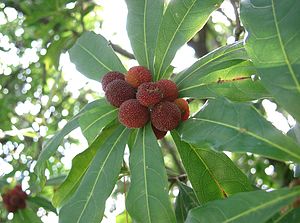Difference between revisions of "Myrica rubra"
Jump to navigation
Jump to search
m (1 revision: Myrica faya, Myrica rubra) |
|||
| (One intermediate revision by the same user not shown) | |||
| Line 8: | Line 8: | ||
}} | }} | ||
| − | + | Keenan has eaten sugared, dried '''yángméi''' (Chinese bayberry) sold as "dried plum". The flavor is good and interesting, reminiscent of [[ume]] with that funky sourness, but mostly it tastes like delicious sweet fruit candy. Still need to try the fresh fruit. | |
| − | + | [[Category:Myricaceae]] | |
| − | + | [[Category:Plants Keenan has eaten]] | |
| − | + | [[Category:Plants with other parts for Keenan to eat]] | |
| − | |||
| − | |||
| − | |||
| − | |||
| − | |||
| − | |||
| − | |||
| − | |||
| − | |||
| − | |||
| − | |||
| − | |||
| − | |||
| − | |||
| − | |||
| − | |||
| − | |||
| − | |||
| − | |||
| − | |||
| − | |||
| − | |||
| − | |||
| − | |||
| − | |||
| − | |||
| − | |||
| − | |||
| − | |||
| − | |||
| − | |||
| − | |||
| − | |||
| − | |||
| − | |||
| − | |||
| − | |||
| − | |||
| − | |||
| − | |||
| − | |||
| − | |||
| − | |||
| − | |||
| − | |||
| − | |||
| − | |||
| − | |||
| − | |||
| − | |||
| − | |||
| − | |||
| − | |||
| − | |||
| − | |||
| − | |||
| − | |||
| − | |||
| − | |||
| − | |||
| − | |||
| − | |||
| − | |||
| − | |||
| − | |||
| − | |||
Latest revision as of 16:18, 6 October 2021
| Myrica rubra | |
|---|---|

| |
| Myrica rubra in garden | |
| Scientific classification | |
| Kingdom: | Plantae |
| Clade: | Angiosperms |
| Clade: | Eudicots |
| Clade: | Rosids |
| Order: | Fagales |
| Family: | Myricaceae |
| Genus: | Myrica |
| Species: | M. rubra
|
| Binomial name | |
| Myrica rubra | |
| Synonyms | |
Keenan has eaten sugared, dried yángméi (Chinese bayberry) sold as "dried plum". The flavor is good and interesting, reminiscent of ume with that funky sourness, but mostly it tastes like delicious sweet fruit candy. Still need to try the fresh fruit.